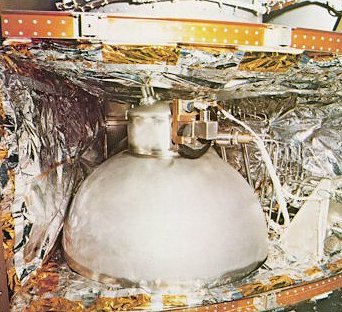















|

|
| "There's one whole side of that spacecraft missing," said Lovell in astonishment. About five hours before splashdown the service module was jettisoned in a manner that would permit the astronauts to assess its condition. Until then, nobody realized the extent of the damage. |

|
| Vital stores of oxygen, water, propellant, and power were lost when the side of the service module blew off. The astronauts quickly moved into the lunar module which had been provided with independent supplies of these space necessities for the landing on the Moon. Years before, Apollo engineers had talked of using the lunar module as a lifeboat. |

|
| Oxygen tank No. 2 overheated and blew up because its heater switches welded shut during excessive prelaunch electric currents. Interior diagram (above) of three-foot-tall oxygen tank No. 2 - whose placement in bay 4 of SM is indicated below - shows vertical heater tube and quantity measurement tube. Heater tube contains two 1800-rpm motors to stir tank's 320 pounds of liquid oxygen. Note thermostat at top. Two switches were supposed to open heater circuit when temperature reached 80° F, but spacecraft power supply had been changed from 28 to 65 Vdc - while contractors and NASA test teams nodded - so switches welded shut and heater tube temperature probably reached 1000° F. |

|

|
| Top of Apollo 13's fuel tank No. 2 (bottom part is below shelf), photographed before it left North American Rockwell plant. Tank was originally installed in Apollo 10's SM, but was removed for modification and in process was dropped two inches (skin of tank is only 0.02 inch thick). Then it was installed on Apollo 13 and certified, despite test anomalies. In raging heat, it burst and the explosion was ruinous to the SM. |

| Nestled amid crinkled metal foil used for thermal insulation, oxygen tank No. 2 was mounted above and close to a pair of hydrogen tanks in spacecraft bay. |


